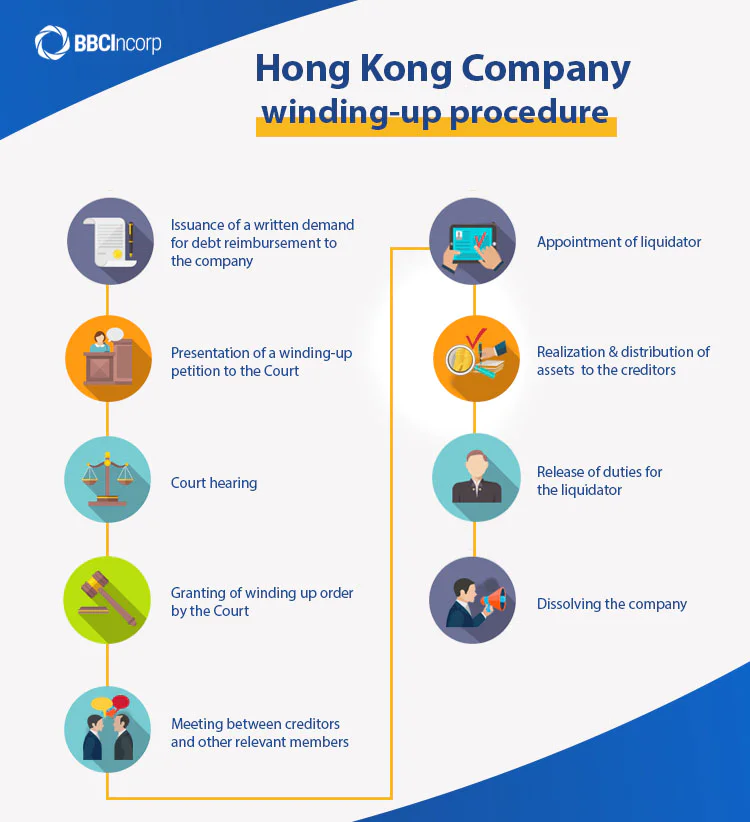
Dissolving a company is a natural part of the business cycle. Given the impact of the Covid-19 pandemic and economic crisis, shutting down your Hong Kong company may be a good idea to lift the burden off your shoulder.
If you’re planning to dissolve your company through winding up, you must know all about the procedures, requirements, as well as its legal effects.
This article will lighten Hong Kong companies’ winding up and easily guide you through the process!
An overview of winding up a company in Hong Kong
In this section, let’s discover the basics of company windup in Hong Kong.
What does “winding up” mean?
When it comes to closing down your business in Hong Kong, you’ve got 2 options: de-registration and winding up (or liquidation).
Even though both can lead your company to shut down, their procedure and feature bear some striking differences.
By deregistering, you’re no longer required to continue your obligations as an officeholder (i.e., director or secretary). Yet, you can’t deregister if your company is insolvent, meaning it’s unable to pay the debt.
On the other hand, you can winding-up your company despite it being solvent or insolvent.
It’s the process of selling all the assets of the company, paying creditors, distributing any remaining assets to the shareholders, and then dissolving the company. After a wind-up has been completed, your company will cease to exist.
For better insights into the differences between winding up and deregistration, let’s go through our Hong Kong Company Deregistration guide.
The process for winding up a company in Hong Kong is quite complicated, with 2 methods you can choose which are Voluntary and Compulsory.
In Hong Kong, the company winding up is regulated by the Companies Ordinance Cap. 32 and Companies Rules Cap 32H.
Free ebook
Everything you need to start business in Hong Kong
Find out in a matter of minutes.

Who can be wound up?
Only a limited company is granted winding up in Hong Kong.
A limited company (LTD) is a separate legal entity, established and registered under Hong Kong Companies Ordinance.
Shareholders’ liabilities in an LTD can be limited to their share values (limited by shares) or limited to the amount of their share contribution to the company’s assets in event of winding up (limited by guarantee).
Tips
Discover more details on Hong Kong limited company and how it differs from a partnership and unlimited company in our related article on Hong Kong Business Entity Types.
Types of winding up a company in Hong Kong
Now you’ve got a basic understanding of company winding-up, let’s learn more about the Voluntary and Compulsory winding-up process.
Voluntary winding up
Voluntary winding up in Hong Kong can be done by creditors or shareholders of your company.
- Shareholders’ voluntary winding up
You may consider the shareholders’ voluntary winding up if your company is solvent – in other words, it can fully pay the debts 12 months from its winding-up commencement.
The process of voluntary winding up is as follows:
(1) Making a Declaration of Solvency Preparing a Statement of Affairs and list of creditors
(2) Adopting a special resolution for the winding up
(3) Submitting the Declaration to CR (within 7 days)
(4) Appointing a liquidator
(5) Notifying CR of the winding up and liquidator appointment (within 14 days after the appointment and passing the resolution)
(6) Publishing in the Government Gazette the winding-up resolution and liquidator appointment (within 14 days after the appointment and passing the resolution)
(7) Realizing and distributing the company’s assets to shareholders/creditors
(8) Arranging a final meeting to present accounts for winding up & pass a special resolution of disposing of books and records
(9) Release of duties for the liquidator
(10) Dissolving the company
The liquidator needs to take care of your company affairs and file notifications regulated by the Companies Ordinance. Importantly, he/she takes responsibility for holding annual general meetings to keep relevant company members updated on the process.
Important
The winding-up process will commence from the date of the special resolution passed.
- Creditors’ voluntary winding up
If your company cannot make a Declaration of Solvency, you can close down with creditors’ voluntary winding up.
The process is as follows:
(1) Preparing a Statement of Affairs and list of creditors
(2) Passing a special resolution for the winding-up
(3) Calling a meeting of creditors for liquidator appointment, the inspection committee
(4) Notifying CR of the winding up and liquidator appointment (within 14 days after the appointment and passing the resolution)
(5) Subsequent steps are similar to those of shareholder’s voluntary winding up
The winding-up procedure is quite similar to that of shareholders. However, after the passing of the resolution, you need to hold the creditors’ meeting.
During the meeting, the creditors will nominate a liquidator as well as an inspection committee whose role is to supervise the power performance of the liquidator.
To proceed with the creditors’ voluntary winding up, your company’s directors are required to present a full statement of the company affairs, together with a list of creditors and the estimated amount to their claims before the above meeting.
Compulsory winding up by Court
The below chart illustrates Hong Kong’s winding-up procedure in the most easy-to-follow manner:

The compulsory winding up by the Court can take place under the following circumstances:
- Your company cannot pay the debt of US$10,000 or more;
- Your company should be wound up, as determined by the Court;
- Your company has passed a special resolution for the members to be wound up compulsorily;
- Your company has no members;
- Your company has not conducted any business for one year from its establishment or suspended its business for a whole year.
A creditor, a shareholder, or another company can also deliver a winding-up petition against you by appointing a solicitor.
The petition must be prepared following the Companies Winding Up Rules, the key requirements of which are:
- Paying a deposit of US$11,250 to the Official Receiver;
- Publishing the petition once in the Gazette and once in one English and one Chinese daily newspaper of Hong Kong in 7 clear days;
- Sending a sealed copy of the petition to the registered office or the place of business of the company;
- Submitting an affidavit for verification 4 days after filing the petition with the court.
Once a winding-up petition is filed in the court, the winding-up of your company shall start and a court hearing will take place.
The Court may appoint a liquidator to wind up your company’s affairs. The appointed liquidator is liable for investigating your company and giving instructions on the statement of affairs.
The liquidator also takes control of your company assets and accounting records and proceeds with investigations.
Once your company’s affairs are completely wound up, it will be dissolved.
Quick Note
The complexity of the winding-up procedure is quite obvious. It’s advised that you engage professional experts before opting for these processes.
Effects of winding up the process
The following section provides an overview of the effects of the company winding up.
Effects of voluntary winding up
After the voluntary winding up is put on commencement:
- Your company shall terminate to carry on business except for those activities that may be required to benefit the winding-up process
- Your company’s legality and powers will be kept until completely dissolved
- Any change of company’s members or transfer of shares, excluding the transfer approved by the liquidator, after the voluntary winding up shall be unaccepted
Effects of compulsory winding up
In case of the compulsory winding up, from the commencement of this procedure:
- Your company/creditor/shareholder can apply to the court for staying or restraining any pending action or proceeding against the company
- Any change of the company’s members or transfer of shares, excluding the transfer approved by the court, shall be unaccepted.
Conclusion
To sum up, there are two common ways for a company to wind up in Hong Kong: Voluntary and Compulsory.
Compared to other methods, the winding up of Hong Kong companies is considered to be more complicated for the statutory requirements and the number of steps of each type.
If you’re planning to wind up your Hong Kong limited company, you should engage a trusted professional expert in Company Dissolution and Restoration to guide you through the process – smoothly and securely.
Or, if you simply want support and guidance on any difficulties you encounter, feel free to drop us a message via service@bbcincorp.com.
Disclaimer: While BBCIncorp strives to make the information on this website as timely and accurate as possible, the information itself is for reference purposes only. You should not substitute the information provided in this article for competent legal advice. Feel free to contact BBCIncorp’s customer services for advice on your specific cases.
Industry News & Insights
Get helpful tips and info from our newsletter!
Stay in the know and be empowered with our strategic how-tos, resources, and guidelines.



